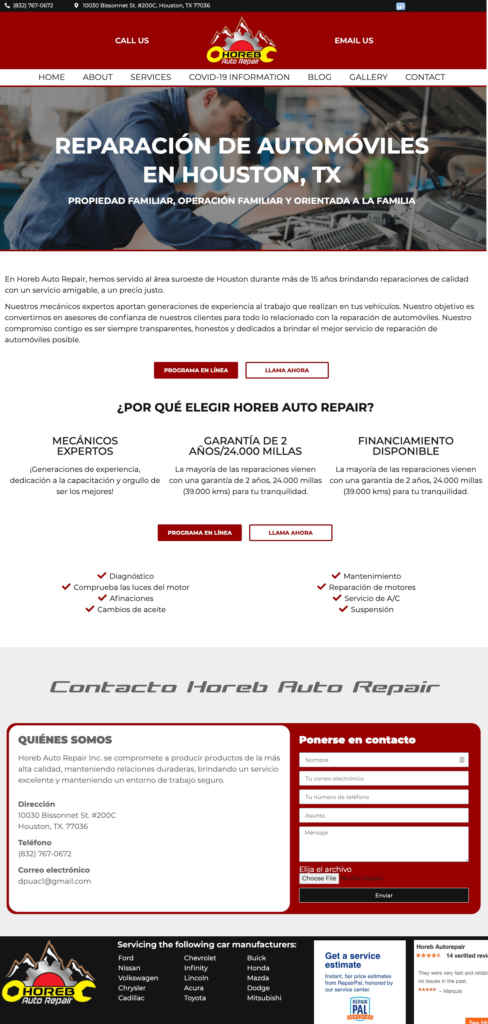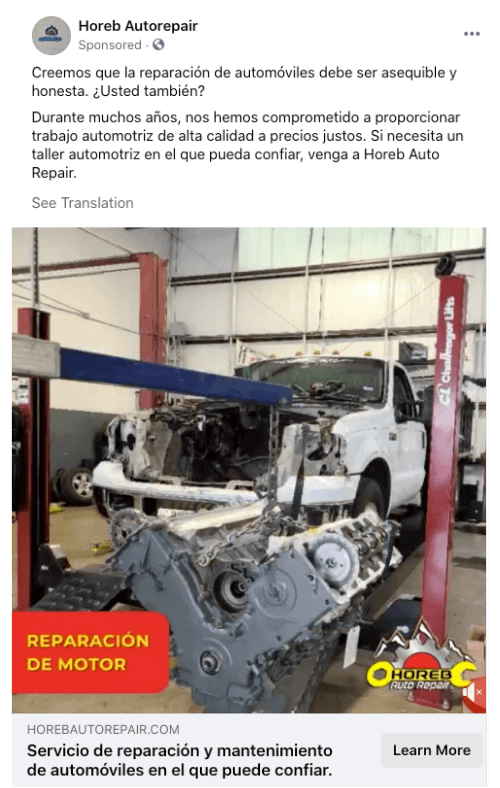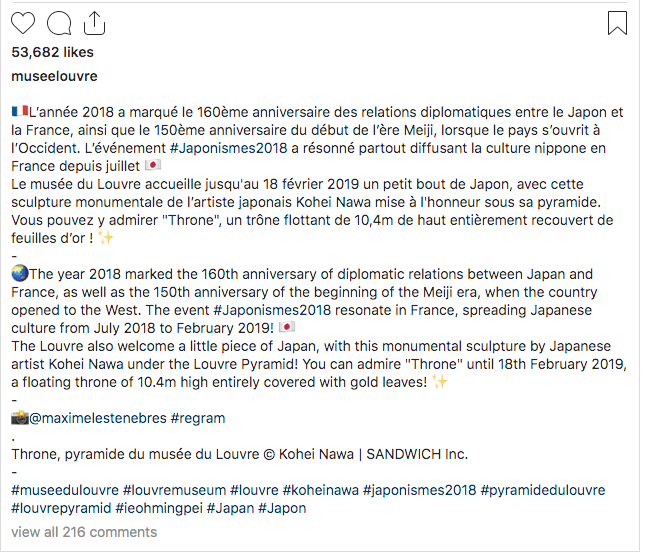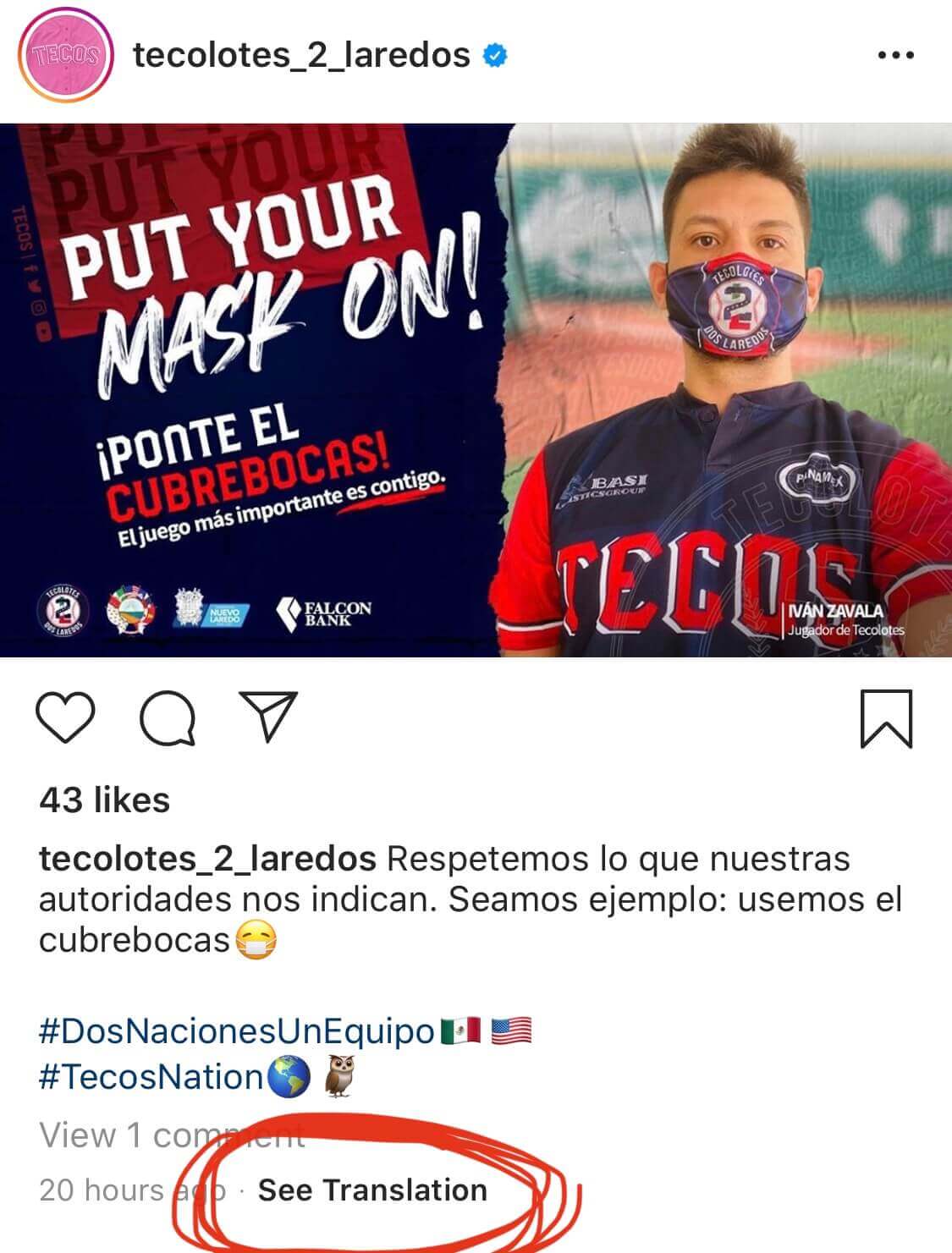Recently we taught a class for the Automotive Service Association’s Florida Chapter. In that session, a shop owner was asking about the methods that could be used to market his shop to both Spanish speaking and English speaking consumers.
At first thought, this might seem somewhat difficult (if not impossible), but we’ve done this in the past for a client in Miami – and we’re currently in the process of putting this into place for one of our clients in Houston, TX – both places where marketing in multiple languages can be a necessity.
Our team got together and the result of that discussion is this blog.
Let’s dig in. We are laying out a plan here that no matter where you are you can put this in place for your shop.
Our team was really excited to talk about this and it opened up some great conversations. Below you’ll find a variety of tips and examples for promoting your shop to the audience you need to attract.
Speaking their Language
There is nothing more frustrating than to be served an ad or receive a promotion; then get to the business and find there is no one there who is able to serve you. This can happen when receiving an ad but the front desk personnel does not know anything about it, or, as it relates to this article, it could be that no one at your shop speaks Spanish. If you are going to spend your time, money and energy attracting Spanish speaking customers, then be prepared to welcome them, service them and help them in their native tongue.
The very first question you should be asking yourself is whether you have the bandwidth to properly serve the audience you are attracting. The simple act of using Google Translate is just not enough.
Be sure that someone on staff can communicate in an effective, compassionate way with your customers.
Let’s take that a step further. Empower your Spanish speaking staff by including them in the planning and the marketing process. Before you launch that ad or that social post, run the text by them to ensure it is properly translated for your audience.
If you want to tap into another culture, you need to also be committed to serving that culture.
Now that we have established the fact that you should be prepared to service those customers, let’s talk about spreading the word.
Include in your marketing messages that you have Spanish speaking team members on staff. This should be on your website, at the bottom of your blogs, on your landing pages, in the ‘about’ section on your social media profiles, in your email marketing and more. Tell the Spanish speaking world that you are equipped, ready and happy to serve them – in their language.
Is Your Website Spanish Speaking Ready?
You may be thinking that you need two different websites. The truth is yes and no. Don’t worry – it’s not as complicated as it may sound!
Localization is the Way to Go.
When we say localization what we mean is you build your website with a primary language. In the USA, the primary should be English, but then you can have a secondary (and beyond) language – Spanish, for example. When you have turned on localization there is a way to input text for the various languages. Your website visitors have their own browsers set to their language of choice. Google sees this. Their browser sees this.
So, if a Spanish speaking person has their browser set to Spanish and searches in Spanish, and your website has a Spanish version, we believe Google is going to rank your website higher for that person. The Spanish version of your website will be displayed to the searcher in the search results.
You’ll see that the URL for your page will change. For instance, if your url is normally autorepairshop.com/vehicle-diagnostics then your new URL will be autorepairshop.com/en-us/vehicle-diagnostics and the Spanish version will be autorepairshop.com/es-es/vehículo-diagnóstico
The browser sees that you have an es-es version of the website, and because the user has their browser set to es-es, that’s the version of the website that is displayed.
If you’re trying to attract Spanish speaking customers then utilizing localization is going to be super important.
Spanish Speaking Specific Landing Page
One way to quickly get started is to simply create a landing page specifically designed for your Spanish speaking audience. A landing page is not an entire website, but rather one page dedicated to one main goal. That goal could be for lead generation or simply a static page created to focus on one purpose.
The landing page is often created as a destination for your audience to visit after clicking on an ad, a link in your email campaign, a social media post, or some other online advertisement.
One of our clients, Horeb Auto Repair, has a landing page we created designed specifically for his Spanish speaking clients. We direct clients there in as many ways as possible: Facebook ads, Google Ads, email marketing, social media, etc. We’ll get more into that in another section. In this section, we want to encourage you to think about creating a page dedicated to serving your Spanish speaking audience.
Point all of your Spanish-focused marketing promotions for that audience to that page.
 What Your Landing Page Needs
What Your Landing Page Needs

Now that you’re thinking that you may want to create a page dedicated to that audience you may be wondering what you need to include on that landing page. Here are some ideas:
- Capture their attention with imagery that they can connect to. In other words, include Hispanics in your images. You will want your audience to see themselves in the images. If we’ve learned anything in 2020, it’s that diversity is important!
- Solve their problems. What do they need? How can you help them? When creating your headline, your body text, and bullet points – think about connecting to your audience. Show them that you care and that you understand.
- Give them a plan. Make it clear that doing business with you will be easy. Not complicated. No one has time for that! They deserve a quick, speedy service just like the next person and their language should not cause an unequal experience with your shop. Tell them what it looks like to do business with you. For example:
- Step One: Schedule an appointment (make this clickable to a Spanish speaking scheduling form)
- Step Two: We diagnose and provide you with a quote.
- Step Three: You approve the work and we get it done.
- Step Four: Pick up your vehicle and enjoy your day!
- Offer several Call-To-Action buttons. If you’ve gone out of your way to speak the language of your customer, create copy and images in ads to attract them, and they’ve come to your site then chances are you’re going to win them over as a client. BUT not if you don’t make it easy for them to choose you. Is it quick and simple to schedule an appointment? Include the “Programar una Cita” (Schedule An Appointment) button several times on this landing page.
- Include a map and contact information. One thing to think about is having a dedicated phone number specifically for your Spanish speaking promotions only. BUT, be sure that the person who answers THAT number speaks Spanish. Imagine how frustrating it might be to call a business that just promoted they’re Spanish speaking only to be answered by someone who is not and then have to be put on a very long hold while the Spanish speaking team member is found to answer the call.
Digital Ads Done Right
Now that you’ve discovered how to maximize your website and/or landing page, let’s talk about how we will get them there.
Digital Ads can be done incredibly well and create a wonderful result for you whether it’s on Google or Facebook.
When looking to Google or Facebook for targeting your Spanish speaking audience, you can:
- Target audiences based on language (English, Spanish, etc.) and the way the ad platforms know what to do is based on the browser language preference set by your audience.

- For example, with Google Ads you can target Spanish speaking folks but if the Google Ad is in English it will not translate it. The good news: According to a person’s web browser settings, Google will know if the person is likely to speak both English and Spanish. So if you create the ad in Spanish and set the language target to Spanish, Google Ads will serve the ad to people who are likely to speak that language according to the language settings in their browser.
- You can do the same in Facebook Ads, but the cool thing is it WILL translate with the ‘see translation’ button that I’m sure you’ve all seen before.
Some things to think about when creating your ads:

- Choose the Google Ads you want to run
- Contract with someone to have them translated by a professional since the online translators are not 100%
- Create the ads manually in Spanish
- Create a Spanish translated landing page
- When the customer calls, be sure someone answers who speaks Spanish
While today we have translation tools easily accessible, seeing an ad that is already in your native language is more likely to get attention. Google will reward you for this as well.
As mentioned previously, be thoughtful of the graphics and images you use for your ads. Whether you’re using a photograph, a graphic, or a video be sure that you are being inclusive in your imagery. One of the positives to come out of 2020 is that we are finally achieving access to better resources for stock photos which allow us to have more diversity in our advertising.
You Can Win on Social Media, Too
Social media is not a tool to leave out of your marketing toolbox. Instead, learn to work within the guidelines and work with the platforms.

Surely, you’ve seen the “See Translation” button on social media platforms which makes it so much easier to connect with both audiences: English and Spanish speaking.
There are a few things you can do to connect with your audience on social.


- Put the social media text in BOTH language. Yes, really. Sometimes put the English version first (and maybe include the American flag emoji) then just below it put the Spanish version (and maybe include the Mexican flag emoji – or flag of choice for whichever country you prefer that’s Spanish speaking). For the next post, flip it around and go with the Spanish speaking text first followed by the English version next.
- Use relevant hashtags to alert your audience such as #Bilingual #HablamosEspañol. Learn the culture, the interests and the hashtags that relate to your audience. Connect your posts to the conversation using those hashtags.
- Are you sick of hearing me talk about imagery? I keep talking about it because it is THAT important! Include persons of the culture you are trying to attract in your graphics/images. Include Spanish translated text on the graphic, too. But, do it in conjunction WITH the English version.
- If you are doing your social media yourself, then use the Google translator to help you. Enter in your text in English and have Google translate it into Spanish. Copy and paste that into your post. I would highly encourage you to have someone (preferably someone on staff as we discussed before) that you can have proofread for accuracy.
- Use emojis! They are there for you to use and it’s a statistical fact that emojis help improve engagement. Emoji’s are a language we all speak!
Social media doesn’t have to be complicated. You can have fun, educate, inspire and connect with people who speak both languages in a way that is attractive to them both.
Email Marketing is a No-Brainer
Surely, you are collecting an email address from each of your customers. Right? Please say yes. (If your answer is no…. Well, you know what to do. Start getting them.)
I’ve heard some saying that email marketing is dead. Some have even said not to waste your time there. Here’s the thing: that’s fake news. These same people push text (SMS) marketing in place of email.
Guess what? I am a BIG believer in text marketing. Do it. You must. It works. It’s fast.
But there is a time and a place for everything! So, let’s talk about how you can use email marketing to connect with your Spanish speaking customers.
When you collect their email address, find a way in your shop management system to mark them as Spanish speaking. Then when it comes time to send an email, simply export the Spanish speaking customers email list.
Now when you create your email campaign, translate it into Spanish, use Spanish relevant imagery, include links to your landing page dedicated to Spanish speaking customers, and include the phone number that your Spanish speaking employee will answer. Send that email to your Spanish speaking customer list.
By the way, there are email marketing platforms that will allow you to customize the content based on certain information about your subscribers. In email, they call this “personalization”, as you can personalize much more than the language. But most of the platforms an auto repair shop will be using do not have this capability.
In Conclusion
You’ve got a lot to think about now when it comes to promoting your shop to both an English speaking and Spanish speaking audience. A bonus: we’re inclined to guess that there are not a lot of folks doing this properly. It’s probably an untapped audience. So, I hope that this blog inspires you to take the next step. They need you and you need them. It’s a win-win!
I’d love to hear from you. Contact me to tell me what you thought about this blog, if you have any new ideas to add or if there’s something from this blog you plan to put into place.
Of course, we want you to try this out, but if you would rather have someone just take this off of your plate, let us know. We’d love to help. Schedule a demo with us and we’ll chat about increasing your exposure to the Spanish speaking community.

About The Author
Kim Walker
In addition to being co-owner of Shop Marketing Pros, Kim is a Master Certified Solution Provider with Constant Contact and a StoryBrand Certified Guide. Kim is a past shop owner and has served as President of ASA North Carolina.


 What Your Landing Page Needs
What Your Landing Page Needs

